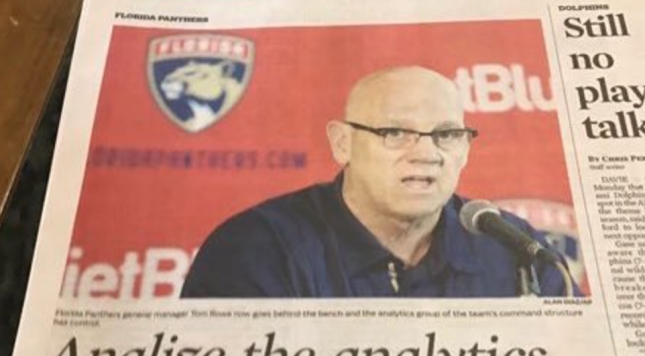[link_box id=”22277″ site_id=”17″ layout=”link-box-third” alignment=”alignright”]The year is mercifully drawing to a close. The year 2016 wasn’t as unkind to the game of hockey as it was to celebrities, 3-1 leads or humanity in general. Still, there was plenty to complain about in the world of hockey this year. So naturally, there are a few things we’d like to leave behind as the calendar flips to 2017.
The analytics divide
We’re at about the half-decade mark of analytics being a major topic of debate. Over the past two or so years, the debate has slowed a bit as more teams and members of the mainstream media accepted them in one form or another. But it’s still an issue that pops up from time to time. The most common fuel for the fire this season has been the Florida Panthers.
In short, the Panthers came on strong last year for first time in about two decades, winning the Atlantic Division. This coincided with the franchise attempting to become more analytics-oriented, something that would be difficult to do with a GM and coach that didn’t believe strongly in that type of analysis. So, Dale Tallon essentially got stripped of his day-to-day power and Gerard Gallant got fired just as soon as the team went on a long enough losing streak. The “hockey guys” were not happy with this, obviously. Even many of the analytics-friendly mainstream guys didn’t understand why they would try to fix something that wasn’t broken.
None of that is anything out of the ordinary. It’s the tone of the criticisms and defenses that stand out. Florida is as vocally pro-analytics as any franchise in the league right now, which seems to have bought them an absurd amount of credit in the analytics community. It feels as though they can do no wrong just because they’re publicly in support of advanced stats. On the other hand, it seems many of the crustier, less number-inclined types have it out for the Panthers. These disparate responses can be chalked up to the analytics divide more than anything else. Just the acceptance that this is a reasonable way to run a franchise but not necessarily a foolproof way to success seems like a reasonable compromise.
Concussion spotter issues
This one is pretty simple: concussion spotters need to be able to do their jobs without interference. That begins and ends with full cooperation from coaches and players. Recently concussed players obviously aren’t going to want to come off the ice, that’s natural. But coaches have to instill in their teams that a spotter calling for a player to go into protocol is a demand, not a request.
Earlier this season, Connor McDavid was tripped, hit his head on the ice and was pulled off by spotters. He returned soon after, but his teammates were unhappy he was removed at all. Patrick Maroon questioned the move, citing hockey being a “man’s game.” I understand he’s frustrated that the team’s best player was off the ice for what turned out to be nothing but a player thinking he knows better than a professional when it comes to which hits require the protocol is absurd. This isn’t a bump or bruise, it’s the type of injury that has the potential to ruin a life. It should be treated with the utmost importance.
Career achievement awards
Drew Doughty won one of these this year, sure. But so did Sidney Crosby with the Conn Smythe. And this is nothing new. Martin Brodeur won a couple of Vezina’s this way. Nicklas Lidstrom probably wasn’t the best defenseman in the NHL at age 40 in 2011. The simple solution is to ignore narratives and just vote for whoever had the best season. More of that in 2017.
Team USA
I’m not saying we’d like to leave American hockey as a whole in 2016, but rather the team that took the ice at this year’s World Cup. America does not have the hockey talent Canada does. That is not in question. Team USA will likely not be the favorite in an international best-on-best tournament for quite a while, if ever.
The only way to approach this is to put out as talented a team as possible and hope your goaltender can steal a few games. America’s most successful international tournament in the past 20 years was the 2010 Olympics. But Team USA brass took the wrong lesson from that fun two-week run. In their minds, the team beat Canada once and forced overtime in the second game by being the tougher, more physical team. Grit, compete, all those unquantifiable buzzwords. But they didn’t out-play Canada at all. They were out-shot 84-59 in those two games. Ryan Miller put up an other-worldly .940 while facing a consistent barrage of Canadian blasts.
In short, the team wasn’t very good. Miller was. Put the best players on your team, hire a good coach and pray to the puck luck God. It’s really not that hard.
The inferiority complex
I’m not naïve, I know this is a long shot. I just hope we can leave a little percentage of the constant “please like my sport” vibe the hockey fandom community puts out.
Hockey isn’t one of the three most-popular sports in America. It doesn’t get much play on highlight shows. The average American cares a lot more about the personalities and social lives of NBA and NFL players.
And that’s all ok. No one has to like the sport but YOU. If you enjoy watching hockey, that’s all that matters. As long as you can catch the nightly recap on NHL Network, who cares how much Sportscenter shows? This is supposed to be fun. Life’s too short to waste time getting mad about how popular your hobby is.
Leave that hurt behind. It’s time to move onto 2017.

